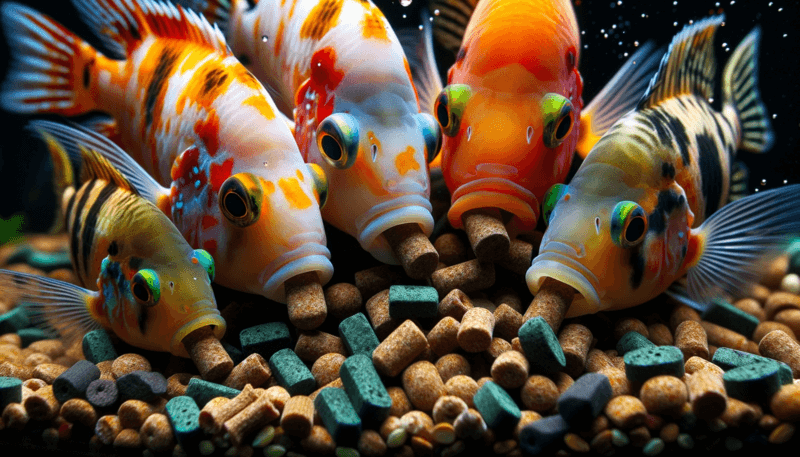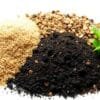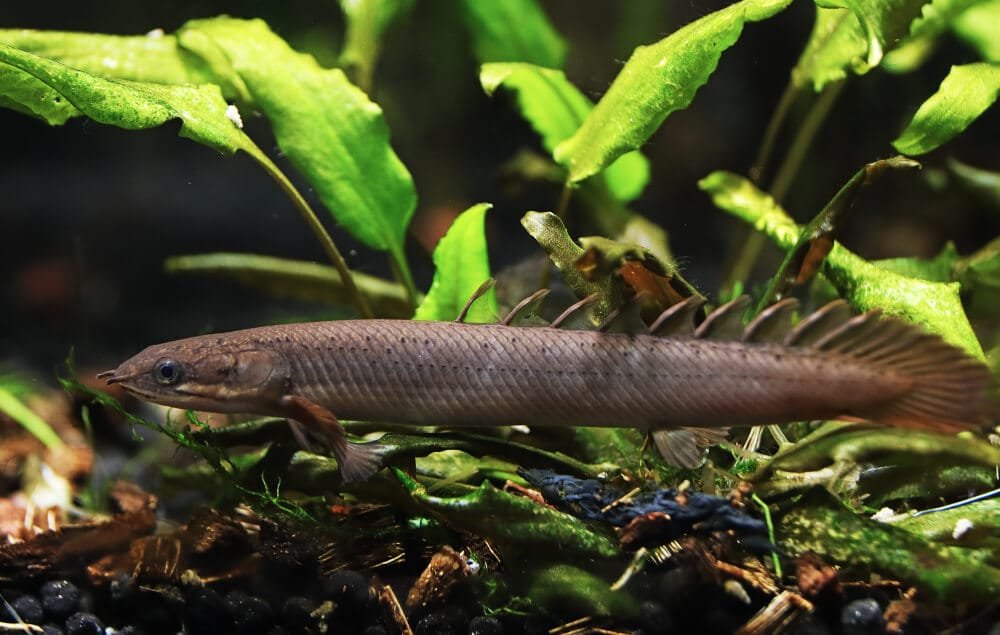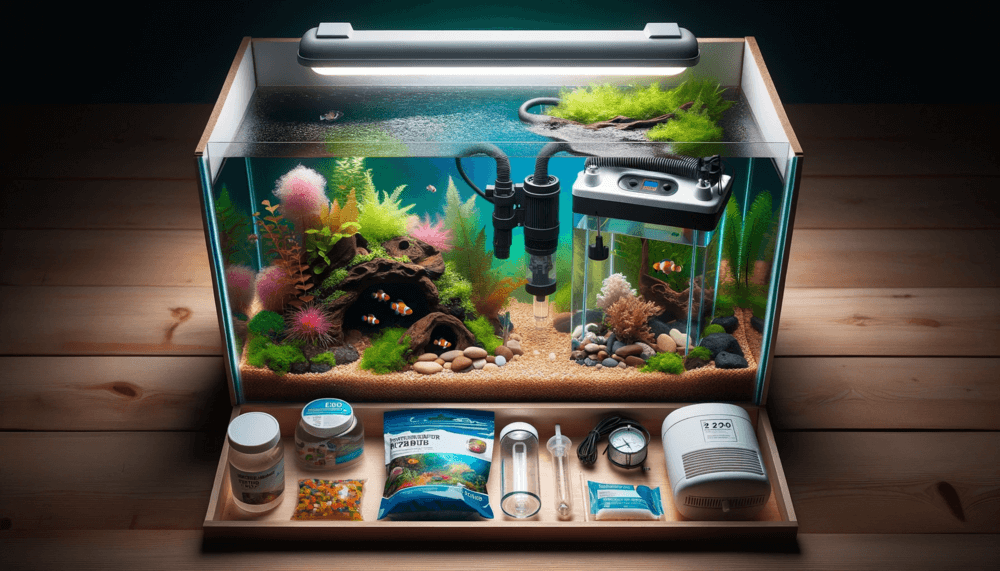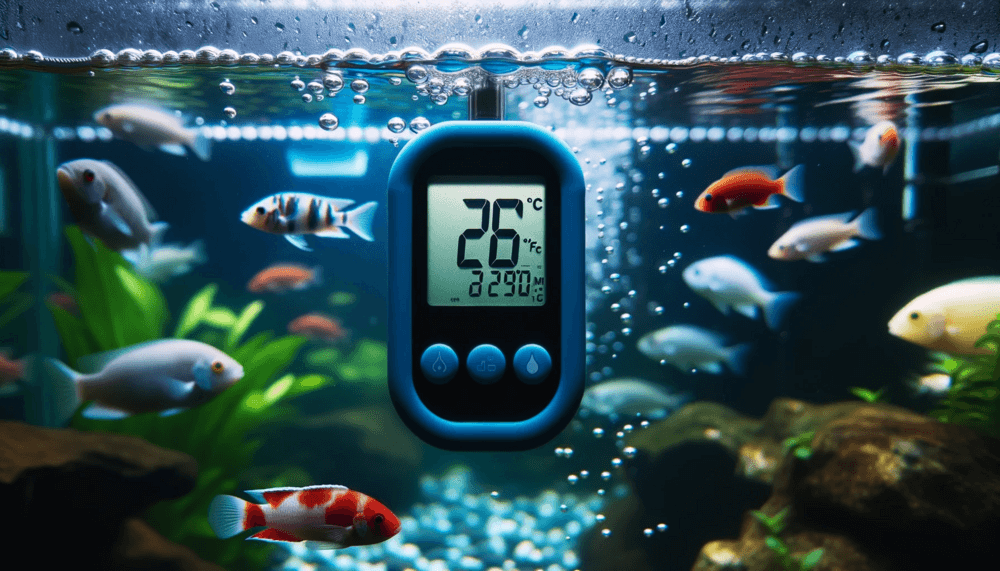Are you accidentally starving or overfeeding your aquarium friends? It’s important to know how often and what to feed your fish. This can make a big difference in their health and happiness.
Fish nutrition is a delicate balance. Most fish do well with one feeding per day. But, some species might need two smaller meals. It’s not the same for all fish.
Different fish have different needs. Growing fish and slow grazers might need three to five small meals daily. Adult fish can usually go a week without food. It’s key to know what your fish needs and watch how they eat.
Beginners often have trouble with portion control. They usually think fish need more food than they do. A good rule is to give about 1% of the fish’s weight in dry food daily. Tropical fish food types vary a lot, so it’s important to feed them just right.
Understanding Basic Fish Nutrition Requirements
Feeding fish right is more than just throwing food into the tank. It’s a science that needs you to know what each fish species eats. This knowledge is vital for their health.
Fish need a balanced diet to stay healthy. The diet of each fish is different. It usually includes proteins, fats, carbs, vitamins, and minerals.
- Proteins (18-50%): Essential for growth and tissue repair
- Lipids (10-25%): Provide energy and essential fatty acids
- Carbohydrates (15-20%): Serve as an energy source
- Vitamins and minerals: Support metabolic functions
Essential Nutrients for Fish Health
Every nutrient is important for fish health. Proteins are key, as most fish need 10 essential amino acids. Marine fish need more omega-3 fatty acids than freshwater fish.
“A good quality prepared fish food should provide all essential vitamins, including A, C, D, E, K, and B group vitamins.” – Aquarium Nutrition Experts
Different Dietary Needs by Species
Feeding saltwater fish is different from freshwater fish. Carnivorous fish need more protein, while herbivorous fish eat more plants. You must tailor feeding to each fish’s needs.
| Fish Type | Protein Requirement | Feeding Frequency |
|---|---|---|
| Marine Shrimp | 18-20% | 2-3 times daily |
| Catfish | 28-32% | 2 times daily |
| Tilapia | 32-38% | 3 times daily |
The Role of Water Temperature in Digestion
Water temperature affects how fish digest food. Warmer water speeds up their metabolism. This means tropical fish might need to eat more often than cold-water fish.
Knowing these nutrition basics helps you create a good feeding schedule. This supports your fish’s health and helps them live longer.
How Often and What to Feed your Fish
Feeding aquarium fish needs careful attention to portion control and nutritional needs. Most fish do well with one to two feedings a day. But, the right amount depends on the fish’s type, age, and diet.
It’s important to pick the right food for your fish. You can choose from:
- Dry food: Pellets and flakes for easy feeding
- Frozen food: High in protein for nutrition
- Live food: Gives natural hunting fun
- Specialized diets: Made for certain fish types
*The key is quality over quantity when feeding aquarium fish.*
Feeding guidelines say most fish should eat their food in 2-5 minutes. Too much food can harm water quality and fish health. Look out for signs like uneaten food, cloudy water, or swollen bellies in fish.
| Fish Type | Feeding Frequency | Recommended Portion |
|---|---|---|
| Adult Fish | 1-2 times daily | What fish can eat in 2-3 minutes |
| Growing Fish | 3-5 small meals | Smaller, more frequent portions |
| Herbivorous Fish | More frequent feeding | Multiple small meals |
Experts say to have a regular feeding schedule. Some even skip feeding one day a week. This helps avoid overfeeding and keeps fish healthy.
Types of Fish Food Available
Choosing the right fish food is key to keeping your fish healthy. Each fish species has its own eating habits and needs. It’s important to know the different food options available.

Aquarium lovers have many food choices to meet their fish’s needs. These choices help keep their fish well-fed and healthy.
Dry Foods: Flakes, Pellets, and Wafers
Dry foods are the most common choice for fish food. Flake foods are good for many fish, while pellets are better for certain sizes:
- Flakes: Easy to digest and good for most fish
- Pellets: Come in floating and sinking types
- Wafers: Best for fish that live on the bottom, like plecos
Live and Frozen Food Options
Live and frozen foods are great for special diets. They offer more nutrients and mimic natural food:
- Bloodworms: High in protein, great for meat-eating fish
- Brine shrimp: Perfect for small and young fish
- Frozen foods: Better than dry foods in terms of nutrition
Gel and Freeze-dried Foods
New food options are always coming out. They help improve fish nutrition:
| Food Type | Benefits | Recommended Use |
|---|---|---|
| Gel Foods | High moisture content | Soft-mouthed fish |
| Freeze-dried Foods | Nutrient-dense | Occasional supplement |
“Variety is key in maintaining optimal fish health and nutrition.” – Aquarium Nutrition Expert
It’s important to watch how much food you give and when. This helps avoid overfeeding and keeps the water clean. Mix up the food types to give your fish a balanced diet.
Identifying Your Fish’s Feeding Habits
It’s important to know how different fish eat to keep them healthy. Fish have their own ways of eating, depending on where they live. This includes tropical, freshwater, and marine fish.
People who keep fish in tanks need to understand their eating habits. Some fish like to eat at the surface, while others prefer the middle or bottom of the tank. Knowing these habits helps make sure they get the right food for their health.
“Know your fish’s natural feeding style to provide the best possible nutrition.”
Feeding Behaviors by Tank Level
- Surface Feeders: Typically tropical fish that consume food directly from the water’s surface
- Mid-Water Feeders: Fish that hunt and eat in the middle of the tank
- Bottom Dwellers: Species that scavenge and consume food from the tank’s substrate
The food you give your fish should match their needs. Each fish type needs different food to stay healthy and strong.
| Fish Type | Feeding Behavior | Recommended Food |
|---|---|---|
| Tropical Fish | Surface/Mid-water | Flakes, small pellets |
| Freshwater Bottom Dwellers | Bottom of tank | Sinking pellets, wafers |
| Marine Fish | Varied feeding levels | Specialized marine foods |
Watching how your fish eat helps you feed them right. Look for signs they’re hungry, like swimming near food or at the surface.
Creating an Effective Feeding Schedule
Creating a consistent feeding schedule is key for healthy fish in your aquarium. It ensures they get the right nutrition. This also helps avoid water quality problems and health issues.
Feeding fish well needs careful planning. You must know what your fish need. Different fish have different diets, affecting how much and how often they eat.
Morning vs Evening Feeding
Experts say a set feeding time is best. Most fish do well with 1-3 small meals a day. These are usually in the morning and evening. The best time depends on your fish’s natural habits.
- Morning feedings give fish energy for the day
- Evening feedings support their metabolism while they rest
- Sticking to a routine lowers stress for your fish
Multiple Feeding Sessions
Some active fish, like Anthias and Chromis, might need up to 5 meals a day. It’s important to watch the food’s freshness and size for each fish.
“Feed what they can eat in 1-2 minutes to cut down waste and keep water clean.”
Adjusting for Different Species
Feeding times change based on what each fish needs:
| Fish Type | Feeding Frequency | Food Recommendation |
|---|---|---|
| Carnivorous Fish | 2-3 times daily | Protein-rich sinking food |
| Herbivorous Fish | 3-5 small meals | Vegetable-based floating food |
| Omnivorous Fish | 2-3 times daily | Mixed diet with varied food sizes |
Pro tip: Always watch how your fish act and adjust how much you feed. This helps avoid overfeeding and keeps the water quality good.
Signs of Proper Feeding Amounts
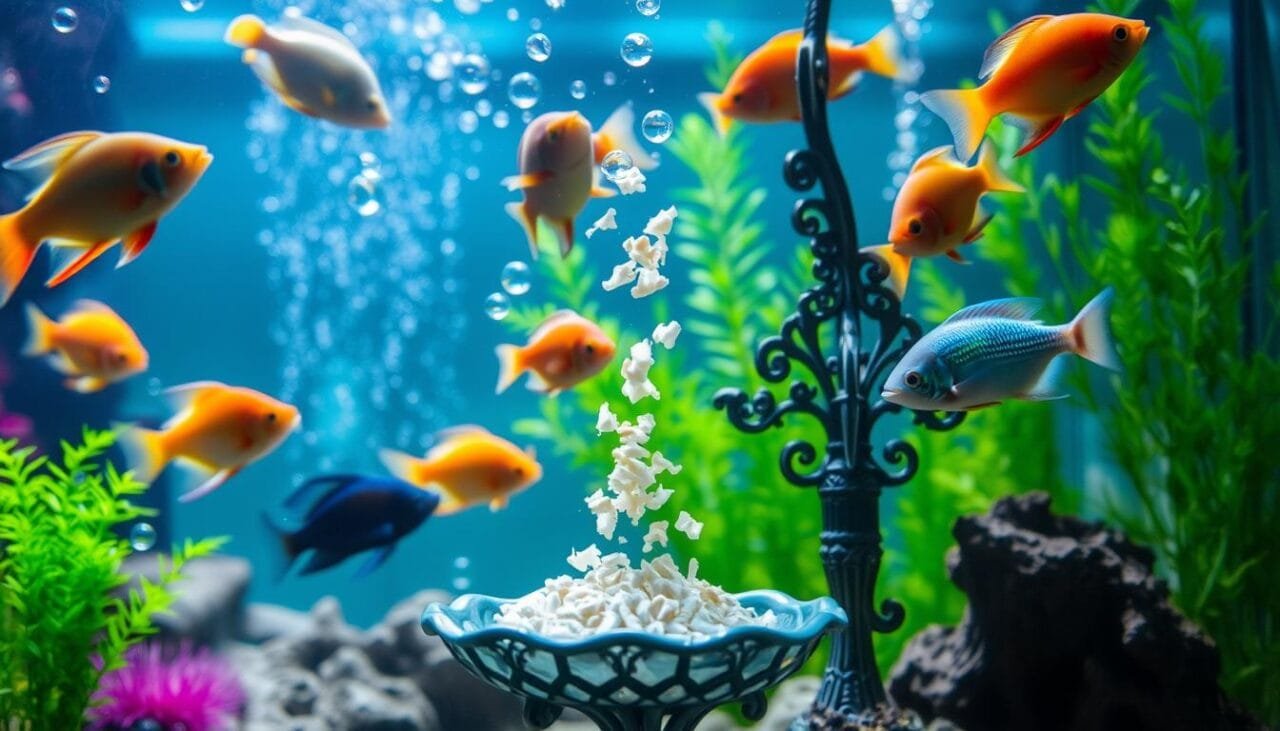
Knowing how to feed your aquarium fish right is key to their health. It’s not just about throwing food in the tank. You need to watch closely and feed just the right amount.
Figuring out the best amount to feed involves a few important signs:
- Slightly rounded belly without too much bloating
- Fish that are active and full of energy
- All food eaten in 5-10 minutes
- Water that’s clear and free of leftover food
Watching your fish’s feeding response is important. This is true whether you’re feeding by hand or using an automatic feeder. Look for these signs of good nutrition:
- Fish that swim quickly to get food
- Always hungry at meal times
- Keeping a healthy weight
- No leftover food on the tank bottom
“Balanced nutrition is more important than quantity” – Aquarium Nutrition Experts
Using different feeding methods and food variety helps your fish get the nutrients they need. Most fish do well with one to two small meals a day. They should eat everything in 30 seconds.
Pro tip: Keep an eye on your tank’s water quality too. High nitrate levels can mean you’re feeding too much.
Dangers of Overfeeding Fish
It’s key to feed fish right to keep them healthy. Too much food can mess up the water and how fish digest it.
Impact on Water Quality
Too much food is bad for fish tanks. When it breaks down, it makes harmful stuff and ammonia. These can hurt fish and mess up the tank’s filters.
- Decomposing food reduces dissolved oxygen
- Increases toxic ammonia and nitrite levels
- Promotes harmful algae growth
- Compromises water chemistry balance
Health Issues from Excess Food
Too much food can harm fish. It can cause fatty liver disease in some fish, like African cichlids and rainbowfish.
“Prevention is always better than cure in maintaining aquarium health.” – Aquarium Experts
Prevention and Solutions
Here are ways to avoid overfeeding and keep fish healthy:
- Feed small portions matching fish’s vitamin supplements requirements
- Remove uneaten food within 5 minutes
- Adjust seasonal feeding patterns
- Monitor fish’s mineral content intake
Doing regular water changes and watching fish helps keep the tank healthy. Knowing what each fish needs helps avoid water problems.
Recognizing and Preventing Underfeeding
Underfeeding is as bad as overfeeding for fish in aquariums. It’s important to watch how much food they eat. This helps keep them healthy.
Signs of underfeeding include:
- Visible weight loss
- Increased aggression during feeding times
- Unusual behavior or lethargy
- Transparent or sunken appearance
“A fish’s appetite reflects its overall health and well-being.” – Aquarium Experts
Different fish need different foods. Carnivorous fish eat a lot of protein. Herbivorous fish prefer plants. Omnivorous fish eat a mix of both.
| Fish Type | Feeding Frequency | Portion Size |
|---|---|---|
| Carnivorous Fish | 2-3 times daily | Small protein-rich portions |
| Herbivorous Fish | 3-4 times daily | Plant-based foods in small amounts |
| Omnivorous Fish | 2-3 times daily | Mixed diet with balanced nutrients |
To prevent underfeeding, watch how your fish act. Know what they need to eat. Feed them at the same times every day.
In community tanks, big fish shouldn’t stop little fish from eating. Make sure everyone gets food. Watch how they eat to avoid problems.
Special Feeding Considerations for Different Fish Species
Knowing what each fish species needs is key to keeping them healthy. Fish nutrition changes a lot between species. So, a single feeding plan won’t work for all.
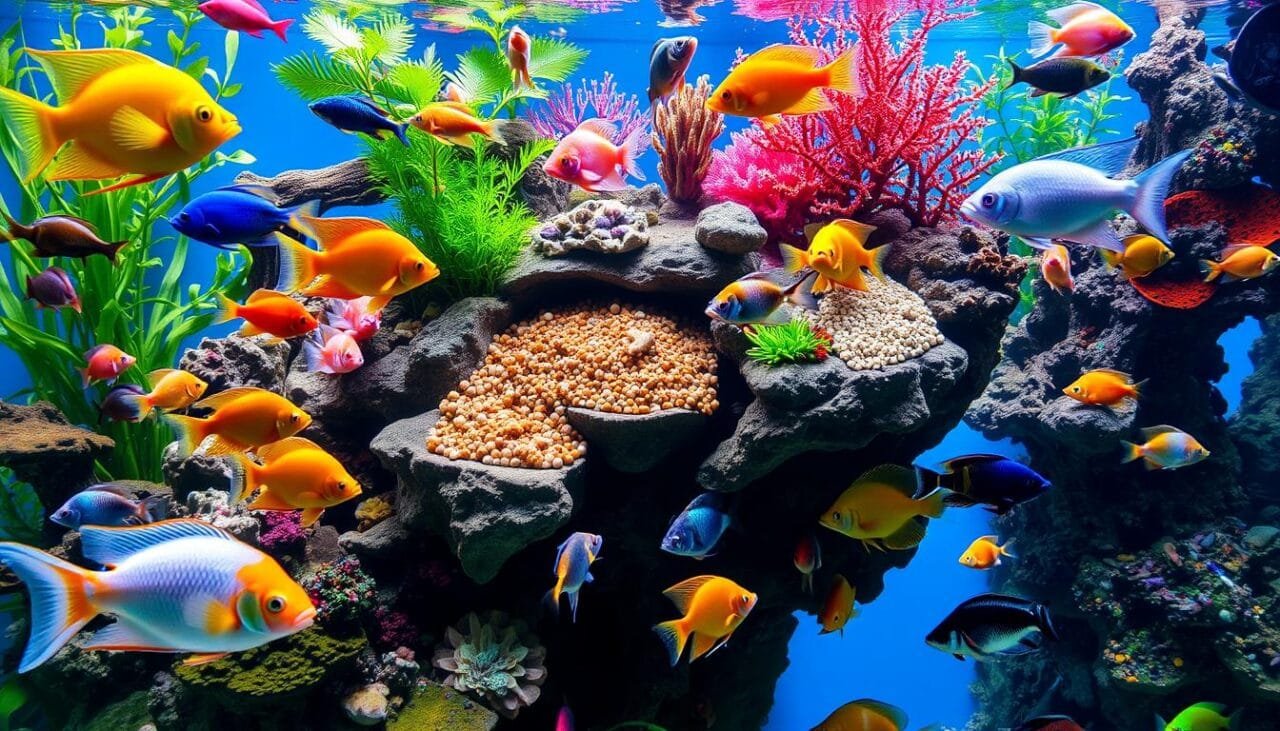
Each fish in your tank needs its own special diet. The right food helps them stay healthy and happy. The place where you feed them is also important.
Carnivorous Fish Nutrition
Carnivorous fish need lots of protein. This is because they hunt for meat in the wild. Foods like:
- Bloodworms
- Brine shrimp
- Frozen beef heart
- Live insects
Herbivorous Fish Requirements
Herbivorous fish, like many catfish, eat plants. Their diet should include:
- Vegetable tablets
- Algae wafers
- Blanched vegetables
- Live aquarium plants
Omnivorous Fish Diets
Omnivorous fish, the most common in home tanks, need a mix of plant and animal foods. Good feeding tips for them are:
- Mixed protein and vegetable-based foods
- Varied diet with different food types
- Smaller, frequent meals
| Fish Type | Feeding Frequency | Recommended Foods |
|---|---|---|
| Angelfish | 2-3 times daily | Granules, bloodworms, flakes |
| Goldfish | 2 times daily | Pellets, flakes, granules |
| Tetras | 2 times daily | Small granules, flakes |
Pro tip: Always adjust feeding time and quantity based on individual fish species, age, and metabolic rates.
Food Storage and Preparation Tips
Storing food properly is key to keeping fish healthy. It helps them absorb nutrients better. This is important for their growth and immune system.
Here are some tips for storing fish food:
- Purchase small containers to prevent nutritional degradation
- Keep dry foods in cool, dry places away from direct sunlight
- Seal packages tightly to maintain freshness
- Check expiration dates regularly
Feeding your fish right is also important. Temperature is a critical factor in food preservation. Store seafood and fish foods at 40°F (4°C) or below to keep them fresh.
“Proper food storage is the foundation of fish nutrition and health” – Aquarium Experts
Each type of fish food needs its own way of preparation:
- Frozen foods: Thaw in refrigerator overnight
- Live foods: Ensure freshness before feeding
- Dry foods: Check for moisture and clumping
Don’t leave prepared food in the tank for too long. Blanched greens like spinach should stay for 1-2 hours. This keeps the water clean and the tank healthy.
Feeding During Vacations and Extended Absences
Planning for fish care when you’re away can be tricky. Adult fish can go a week without food, but longer times need careful planning. Experts say to feed them often to keep them healthy.
It’s key to know what your fish eats to keep them well while you’re away. Each fish type needs different food and eating habits.
- Automatic fish feeders: Cost approximately $25-60
- Casual fish sitter: Around $10 per visit
- Professional fish care: $20 per hour and up
- Vacation fish feeders: About $2-6
Here are some ways to feed your fish while you’re away:
- Automatic Feeders: Great for exact feeding
- Slow-Release Vacation Feeders: Helps avoid food fights
- Professional Pet Sitters: Get personal care for your fish
“Proper preparation prevents poor fish performance during vacation”
| Absence Duration | Recommended Feeding Strategy |
|---|---|
| 1-2 Weeks | Automatic feeder or vacation blocks |
| 2+ Weeks | Professional fish sitter recommended |
Water temperature affects how often fish need to eat. Warmer water means more food. Try your feeding plan before you leave to keep your fish happy and healthy.
Conclusion
To get your aquarium’s digestive system working at its best, focus on feeding habits and what your fish need to eat. It’s not just about throwing food into the tank. Knowing what your fish eat and how water temperature affects them is key to a healthy tank.
Getting the right food to your fish is important. Most tropical fish do well with one or two meals a day. Make sure not to overfeed, as this can harm the water quality. It’s also important to know what each fish species needs, adjusting their diet as needed.
Keeping fish is a journey that requires watching and learning. By following the tips in this guide, you can make sure your fish get the right food. Remember, every fish is different. Be ready to change your approach as needed. Enjoy the journey of caring for a lively, healthy aquarium.
FAQ
How often should I feed my aquarium fish?
Most fish do best with 1-2 feedings a day. Give them small portions they can eat in 2-3 minutes. The right amount depends on the fish type. Some need more food, others less. Watch your fish to avoid overfeeding or underfeeding.
What are the different types of fish food available?
There are many types of fish food. You can choose from dry foods like flakes and pellets, frozen foods like bloodworms, live foods, gel foods, and freeze-dried options. Each type is best for different fish and their needs. Pick food that fits your fish’s diet and natural eating habits.
How can I tell if I’m overfeeding my fish?
Overfeeding signs include uneaten food at the tank bottom, cloudy water, more algae, and bloated fish. It can harm water quality and cause health issues. Feed only what your fish can eat in 2-3 minutes.
What should I do when feeding fish during vacation?
Healthy adult fish can go without food for 1-3 days. For longer trips, use automatic feeders or ask a friend to feed them. Don’t overfeed before you leave to keep water quality good.
How do different fish species have different dietary needs?
Fish are meat-eaters, plant-eaters, or eat both. Meat-eaters need high-protein foods, plant-eaters need plants, and omnivores need both. Always check what your fish needs.
Can I mix different types of fish food?
Yes, mixing foods can give your fish a balanced diet. Many use dry, frozen, and live foods. Just make sure it’s right for your fish and avoid sudden changes.
How does water temperature affect fish feeding?
Water temperature affects how fast fish eat and digest. In warm water, they eat more often. In cool water, they eat less. Watch your fish and adjust feeding based on temperature and species.
What are signs that my fish might be undernourished?
Signs of underfeeding include weight loss, aggression, lethargy, pale color, and less activity. Fish may fight more for food. If you see these signs, increase food or adjust feeding to meet their needs.
